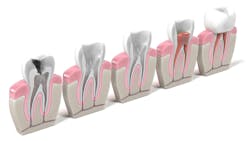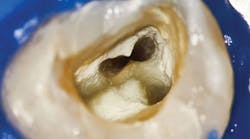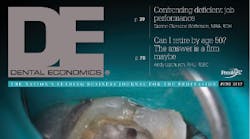My third year in dental school, my clinical instructor said something I’ll never forget: “Get good before you get fast, because if you get fast before you get good, you will never be good.” As someone who has always been about quality, positive outcomes, and doing things the right way, this reverberated deeply with me. To this day I hold these words dear. Why? Because when we perform good, efficient, successful, quality care, we have happy patients and a profitable practice.
I recently spoke to a business associate in the dental field. When I told him I was an endodontist, he remarked, “That’s a very profitable specialty.” I humbly acknowledged his observation and moved the conversation along. Later that day, I thought, “Endo is profitable, but is it profitable for everyone?”
Let’s face it, some dental health-care professionals struggle with root canal therapy (RCT), while others totally avoid it. Ideally, during an endodontic visit, we’d like to be able to diagnose the disease, treat it in a single visit (maybe within an hour), and send the patient home happy. However, things don’t always go as planned, and in some cases, we can lose money on a case.
There are many different components to an endodontic visit that should be considered before cleaning/shaping and obturating (filling) the canals. It took me many years to recognize the importance of and to master these steps. By giving more thought and efficiency in these areas, I realized it would make for an easier endodontic visit. It’s not all about “cleaning and filling” the canals. Even for experienced and highly skilled endodontists, an endodontic visit can be quite humbling at times.
But when consideration and care are given to the following components, the chances of success and profitability should increase favorably:
- Diagnosis
- Case selection
- Preparation and organization
- Adequate anesthesia
- Isolation and use of the rubber dam Access and visibility
Diagnosis
To perform RCT, we need a tooth to treat and a proper diagnosis. Not achieving a proper diagnosis can lead to patient and provider frustration, prolonged pain, repeat and nonbillable appointments, refunds. and excessive and costly chair time. We obtain a proper diagnosis by getting a chief complaint, as much detail as possible from the patient on the history of their illness, and a thorough evaluation.
We need to “put on our detective hats” to make the diagnosis, but diagnosing can be challenging. We need to determine if the pain is odontogenic (tooth-related) or nonodontogenic (not tooth-related). We know certain conditions such as trigeminal neuralgia, sinusitis, myofascial pain syndrome, temporomandibular joint (TMJ) disorders, and other ailments can mimic tooth pain, so we must be strategic with our questioning.
Be mindful that if a patient is currently taking pain medications and/or antibiotics, their pain might be masked. If testing is inconclusive, reappoint the patient and advise them not to take those medications prior to their next appointment.
When diagnosing, ask the right questions and establish a baseline for the patient through thermal and apical testing (percussion and palpation). I like to know if pain is provoked by cold, hot, chewing, or lying down, or if it’s relieved by cool water. When thermal testing with cold and hot, establish a baseline for the patient. Just because one tooth responds significantly to cold does not mean it’s the cause of the pain. Likewise, just because a tooth does not respond to cold does not mean it’s the culprit.
Test several teeth in the area where the patient reports the pain. Be mindful that pain can radiate; in fact, we can see referred pain from maxillary posterior teeth to mandibular teeth, and vice versa. Every patient is different, so what’s normal for one might be different for another. A molar might respond differently than a bicuspid, so be open to testing other teeth in different quadrants to establish that baseline. Typically, we look for the outlier, the tooth that has an intense and lingering response to thermal testing. Do your best to find the outlier, but if you’re not sure, have the patient return to retest and compare findings, or refer to a specialist.
Case selection
In the general dentist setting, you want to be smart about which cases you treat. Be thoughtful about when to refer to an endodontist or an oral surgeon for extraction. Choose cases that appear to be straightforward, especially as you sharpen your endo skills. Cases that might lead to little profit and be best referred to an endodontist include:
- Calcified pulp chambers
- Calcified canals, curved (dilacerated) roots, and canals that tend to “disappear” apically on x-ray
- Cases with large apical lesions
- Cases with significant bone loss
- Teeth with crowns
- Upper first and second molars due to incidence of MB2 (fourth canal) and difficulty locating these canals without a microscope
- Teeth with deep probings
- Teeth with vertical defects of coronal crestal bone noted on x-ray
Attempting to treat these cases can result in depleting supplies quickly, extended chair time, loss of profit, patient disappointment, and provider discouragement.
Preparation and organization
Know your patients. Do some of your patients take longer to anesthetize? Do some have high anxiety that might need sedation or preappointment sedatives? Prepare accordingly and make sure your schedule can accommodate their needs (i.e., limit side books). It can take some time to determine which instruments, equipment, materials, and setup work best for you. But by taking the extra time before clinical care, you set yourself up for success. Having one dental assistant dedicated to your endo cases and developing a routine with that assistant will save you time and frustration. Maximize your procedure time by having all the endo armamentarium properly set up and within arm's reach. Setting up your endo trays the night before treatment gets you off to the right start.
Adequate anesthesia
This might be one of the most critical steps for gaining patient trust, improving the patient experience, and minimizing chair time. Inadequate anesthesia can lead to prolonged appointment times, return visits, and unhappy patients. Know your anatomy, important landmarks for proper delivery, and lesser-used techniques such as the Akinosi block for mandibular anesthesia, and infiltration in the greater palatine foramen area for palatal anesthesia of palatal roots of molars and bicuspids. Delivering anesthesia slowly to minimize pain is a good way to get patients to sing your praises and spread the word about how gentle you are.
Isolation and rubber dam use
This is another critical step that might be overlooked. When performing RCT, the objective is to remove as much of the tissue and pathogens in the canal system as possible as this leads to higher success. Not using a rubber dam or having improper isolation allows bacteria in the saliva to contaminate the root canal system. This defeats the purpose of RCT as contamination will lead to treatment failure. This can lead to continued symptoms, more nonbillable procedures, and patient refunds. Proper isolation will keep the cheek, tongue, and lips out of your way, which allows for easy access and decreased clinical time.
Access and visibility
I access every tooth under a microscope—yes, even numbers 8 and 9! Seeing the internal anatomy of the pulp chamber, locating the canals, and seeing the internal aspect of the canals provides a great sense of comfort and minimizes the risk of perforation. It also takes very little time. A microscope is a smart investment, and sure, there’s a learning curve, but it’s worth the reward.
Think about it: wouldn’t it be timelier and more efficient to access and locate canals in a minute or two versus 10, 15, or 30 minutes? The microscope is a game changer in the world of endodontics. I would say the second-best option for access and visibility is loupes and a headlight. Although RCT does involve a certain feel and touch, you need to see and locate the canals to treat them. Also, consider a bite block for those patients who struggle with opening. This also provides better access.
Endodontic treatment is a profitable service when it’s performed the right way at the right time. However, if appointments are long, recurring, wasteful, and unsuccessful, endo can negatively impact your business model and bottom line. Like any other skill, the key to successful RCT is practice, patience, and education. Sometimes, we need to slow down and give more attention to the phases of care that take place prior to the actual RCT procedure. Remember, “Get good before you get fast, because if you get fast before you get good, you will never be good.”
Editor's note: This article appeared in the April 2024 print edition of Dental Economics magazine. Dentists in North America are eligible for a complimentary print subscription. Sign up here.
Mark Doherty, DMD, is cofounder and CEO of D4 Practice Solutions, owner and CEO of Commonwealth Mobile Oral Health Services, and a partner of Southcoast Endodontics. He is an associate clinical instructor for the postgraduate endodontic residents at the Boston University Henry M. Goldman School of Dental Medicine (BUGSDM). A sixth-generation dentist, Dr. Doherty is a graduate of the University of Pennsylvania School of Dental Medicine. He completed his postdoctoral training at BUGSDM in endodontics and root canal therapy.
About the Author

Mark Doherty, DMD
Mark Doherty, DMD, is cofounder and CEO of D4 Practice Solutions, owner and CEO of Commonwealth Mobile Oral Health Services, and a partner of Southcoast Endodontics. He is an associate clinical instructor for the postgraduate endodontic residents at the Boston University Henry M. Goldman School of Dental Medicine (BUGSDM). A sixth-generation dentist, Dr. Doherty is a graduate of the University of Pennsylvania School of Dental Medicine. He completed his postdoctoral training at BUGSDM in endodontics and root canal therapy.


